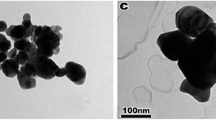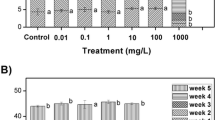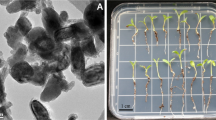Abstract
Currently, the use of nanotechnologies is in rapid expansion, which entails increasing risks of environmental contamination by nanoparticles. Many studies describe the toxic effects on human cells, but little is known about the possible adverse effects on plants. Currently, various nanoparticles are often detected in streams, wastewater, and sewage due to widespread nanoparticle uses. We studied the accumulation and the effect of metal oxide nanoparticles together with their bulk counter particles and soluble metal salts on the growth of a wetland plant species true fox-sedge (Carex vulpina L.). The concentration 100 mg/l of copper nanoparticles significantly affected the growth of the plants, roots characteristics, and content of the photosynthetic pigments in leaves, while the same concentration of iron nanoparticles did not reduced any of the measured items. Using the bulk materials, the effect was very similar.





Similar content being viewed by others
References
Abramova, A., Gedanken, A., Popov, V., et al. (2013). A sonochemical technology for coating of textiles with antibacterial nanoparticles and equipment for its implementation. Materials Letters, 96, 121–124.
Andreotti, F., Mucha, A. P., Caetano, C., et al. (2015). Interactions between salt marsh plants and Cu nanoparticles—effects on metal uptake and phytoremediation processes. Ecotoxicology and Environmental Safety, 120, 303–309.
Anjum, N. A., Adam, V., Kizek, R., et al. (2015). Nanoscale copper in the soil-plant system—toxicity and underlying potential mechanisms. Environmental Research, 138, 306–325.
Aruoja, V., Dubourguier, H.-C., Kasemets, K., et al. (2009). Toxicity of nanoparticles of CuO, ZnO and TiO2 to microalgae Pseudokirchneriella subcapitata. Science of the Total Environment, 407, 1461–1468.
Chang, Y.-N., Zhang, M., Xia, L., et al. (2012). The toxic effects and mechanisms of CuO and ZnO nanoparticles. Materials, 5, 2850–2871.
Giorgetti, L., Castiglione, M. R., Bernabini, M., et al. (2011). Nanoparticles effects on growth and differentiation in cell culture of carrot (Daucus carota L.) Agrochimica, 55, 45–53.
Gopalakrishnan Nair, P. M., & Chung, I. M. (2015). Biochemical, anatomical and molecular level changes in cucumber (Cucumis sativus) seedlings exposed to copper oxide nanoparticles. Biologia, 70, 1575–1585.
Hsieh, S. F., Bello, D., Schmidt, D. F., et al. (2013). Mapping the biological oxidative damage of engineered nanomaterials. Small, 9, 1853–1865.
Hu, C., Liu, Y., Li, X., et al. (2013). Biochemical responses of duckweed (Spirodela polyrhiza) to zinc oxide nanoparticles. Archives of Environmental Contamination and Toxicology, 64, 643–651.
Jeyasubramanian, K., Thoppey, U. U. G., Hikku, G. S., et al. (2016). Enhancement in growth rate and productivity of spinach grown in hydroponics with iron oxide nanoparticles. RSC Advances, 6, 15451–15459.
Kim, S., Lee, S., & Lee, I. (2012). Alteration of phytotoxicity and oxidant stress potential by metal oxide nanoparticles in Cucumis sativus. Water, Air, and Soil Pollution, 223, 2799–2806.
Konotop, Y. O., Kovalenko, M. S., Ulynets, V. Z., et al. (2014). Phytotoxicity of colloidal solutions of metal-containing nanoparticles. Cytology and Genetics, 48, 99–102.
Landa, P., Cyrusova, T., Jerabkova, J., et al. (2016). Effect of metal oxides on plant germination: phytotoxicity of nanoparticles, bulk materials, and metal ions. Water, Air, & Soil Pollution, 227, 448.
Lebedev, S. V., Korotkova, A. M., & Osipova, E. A. (2014). Influence of Fe-0 nanoparticles, magnetite Fe3O4 nanoparticles, and iron (II) sulfate (FeSO4) solutions on the content of photosynthetic pigments in Triticum vulgare. Russian Journal of Plant Physiology, 61, 564–569.
Li, X., Yang, Y. C., Gao, B., et al. (2015). Stimulation of peanut seedling development and growth by zero-valent iron nanoparticles at low concentrations. PloS One, 10, e0122884.
Libralato, G., Devoti, A. C., Zanella, M., et al. (2016). Phytotoxicity of ionic, micro- and nano-sized iron in three plant species. Ecotoxicology and Environmental Safety, 123, 81–88.
Lichtenthaler, H. K. (1987). Chlorophylls and carotenoids—pigments of photosynthetic biomembranes. Methods in Enzymology, 148, 350–382.
Liu, R., & Lal, R. (2015). Potentials of engineered nanoparticles as fertilizers for increasing agronomic productions. Science of the Total Environment, 514, 131–139.
Llorens, A., Lloret, E., Picouet, P. A., et al. (2012). Metallic-based micro and nanocomposites in food contact materials and active food packaging. Trends in Food Science & Technology, 24, 19–29.
Luyts, K., Napierska, D., Nemery, B., et al. (2013). How physico-chemical characteristics of nanoparticles cause their toxicity: complex and unresolved interrelations. Environmental Science: Processes & Impacts, 15, 23–38.
Ma, C. X., White, J. C., Dhankher, O. P., et al. (2015). Metal-based nanotoxicity and detoxification pathways in higher plants. Environmental Science & Technology, 49, 7109–7122.
Masarovicova, E., & Kral’ova, K. (2013). Metal nanoparticles and plants. Ecological Chemistry and Engineering S-Chemia I Inzynieria Ekologiczna S, 20, 9–22.
Nitsch, J. P., & Nitsch, C. (1965). In vitro formation of flowers in a short-day species—Plumbago indica L. Annales De Physiologie Vegetale, 7, 251.
Peng, C., Duan, D. C., Xu, C., et al. (2015). Translocation and biotransformation of CuO nanoparticles in rice (Oryza sativa L.) plants. Environmental Pollution, 197, 99–107.
Perreault, F., Samadani, M., & Dewez, D. (2014). Effect of soluble copper released from copper oxide nanoparticles solubilisation on growth and photosynthetic processes of Lemna gibba L. Nanotoxicology, 8, 374–382.
Rui, M. M., Ma, C. X., Hao, Y., et al. (2016). Iron oxide nanoparticles as a potential iron fertilizer for peanut (Arachis hypogaea). Frontiers in Plant Science, 7, 815.
Shaw, A. K., Ghosh, S., Kalaji, H. M., et al. (2014). Nano-CuO stress induced modulation of antioxidative defense and photosynthetic performance of Syrian barley (Hordeum vulgare L.) Environmental and Experimental Botany, 102, 37–47.
Song, G. L., Hou, W. H., Gao, Y., et al. (2016). Effects of CuO nanoparticles on Lemna minor. Botanical Studies, 57(1), 3.
Thwala, M., Klaine, S. J., & Musee, N. (2016). Interactions of metal-based engineered nanoparticles with aquatic higher plants: a review of the state of current knowledge. Environmental Toxicology and Chemistry, 35, 1677–1694.
Wang, Y. G., Aker, W. G., Hwang, H. M., et al. (2011a). A study of the mechanism of in vitro cytotoxicity of metal oxide nanoparticles using catfish primary hepatocytes and human HepG2 cells. Science of the Total Environment, 409, 4753–4762.
Wang, H. H., Kou, X. M., Pei, Z. G., et al. (2011b). Physiological effects of magnetite (Fe3O4) nanoparticles on perennial ryegrass (Lolium perenne L.) and pumpkin (Cucurbita mixta) plants. Nanotoxicology, 5, 30–42.
Zhao, M. H., Xu, Y., Zhang, C. S., et al. (2016). New trends in removing heavy metals from wastewater. Applied Microbiology and Biotechnology, 100, 6509–6518.
Acknowledgements
This study was supported by projects MYES of CR no. LD14100 and no. LD13028.
Author information
Authors and Affiliations
Corresponding author
Rights and permissions
About this article
Cite this article
Cyrusová, T., Petrová, Š., Vaněk, T. et al. Responses of Wetland Plant Carex vulpina to Copper and Iron Nanoparticles. Water Air Soil Pollut 228, 258 (2017). https://doi.org/10.1007/s11270-017-3436-z
Received:
Accepted:
Published:
DOI: https://doi.org/10.1007/s11270-017-3436-z




